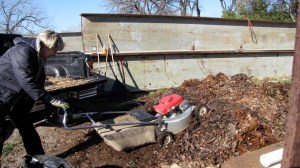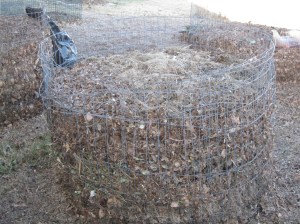 Compost is recycled organic material. Grass clippings, leaves and plant refuse, things that used to be thrown into the landfill, are converted with the help of microbes, molds and insects into food for our garden.
Compost is recycled organic material. Grass clippings, leaves and plant refuse, things that used to be thrown into the landfill, are converted with the help of microbes, molds and insects into food for our garden.
WHAT DO YOU NEED TO MAKE COMPOST?
(4 components + tools)
NITROGEN – GREEN – Grass clippings, Fruit & Vegetable Scraps, Coffee Grounds
CARBON – BROWN – Dried leaves, dried plants, shredded paper, wood chips (also known as mulch)
MOISTURE – BLUE – Water, leftover juices from drinks, pickle juice, jams, jelly, any liquid containing sugar
OXYGEN – WHITE – Air/circulation
HOW DOES IT BECOME COMPOST?
Mix the above 4 ingredients and let nature take over. All around us are small animals called MICROBES. Like any animal, they like to eat. Feed them and they multiply. Their food is the materials we mixed together (green, brown) with the water. The air/oxygen allows them to live.
HOW SHOULD A COMPOST PILE LOOK?
Compost bins/piles can be as simple as a pile on the ground or as elaborate and a hand or machine cranked barrel. MASS is more important in composting than its container. The deeper and wider the pile, the faster it will compost. Good dimensions are 3’ deep and 3-4’ in diameter. Piles can be square, rectangular, or round.
 The outside edge (as much as 12” can dry out fairly quickly so I prefer the round style—acts like an insulator. The interior stays moist and heats up with microbial activity. When the pile is turned, the dry outer material is stirred into the moist interior and helps to aerate the pile. Depending on your available space, it is nice to have more than one container so you can move the compost when turning it. Three containers allow you to have compost at different stages of maturation; new, in-process, finished.
The outside edge (as much as 12” can dry out fairly quickly so I prefer the round style—acts like an insulator. The interior stays moist and heats up with microbial activity. When the pile is turned, the dry outer material is stirred into the moist interior and helps to aerate the pile. Depending on your available space, it is nice to have more than one container so you can move the compost when turning it. Three containers allow you to have compost at different stages of maturation; new, in-process, finished.
WHAT IS COMPOST GOOD FOR?
1) Feeding plants and soil animals (worms, insects, microbes)
2) Rebuilding the soil by improving its friability and fertility
3) Improving the ability of the soil to absorb moisture, avoiding excess runoff and erosion
4) Keeping organic materials out of our landfills
What we had to get from outside sources when we first began our garden, we are now able to produce in our COMPOST area. Not only do we feed our many garden areas, but are also able to furnish our fellow gardeners with food for their gardens.
Cindy





 Compost is recycled organic material. Grass clippings, leaves and plant refuse, things that used to be thrown into the landfill, are converted with the help of microbes, molds and insects into food for our garden.
Compost is recycled organic material. Grass clippings, leaves and plant refuse, things that used to be thrown into the landfill, are converted with the help of microbes, molds and insects into food for our garden. The outside edge (as much as 12” can dry out fairly quickly so I prefer the round style—acts like an insulator. The interior stays moist and heats up with microbial activity. When the pile is turned, the dry outer material is stirred into the moist interior and helps to aerate the pile. Depending on your available space, it is nice to have more than one container so you can move the compost when turning it. Three containers allow you to have compost at different stages of maturation; new, in-process, finished.
The outside edge (as much as 12” can dry out fairly quickly so I prefer the round style—acts like an insulator. The interior stays moist and heats up with microbial activity. When the pile is turned, the dry outer material is stirred into the moist interior and helps to aerate the pile. Depending on your available space, it is nice to have more than one container so you can move the compost when turning it. Three containers allow you to have compost at different stages of maturation; new, in-process, finished. 
